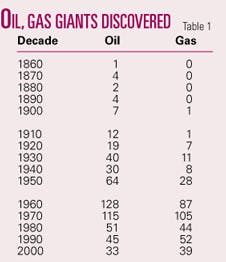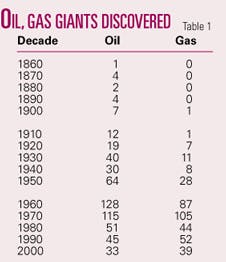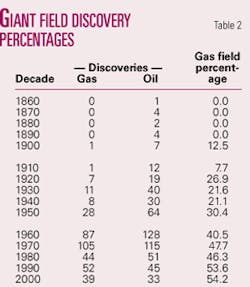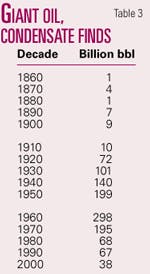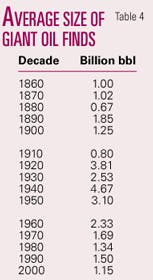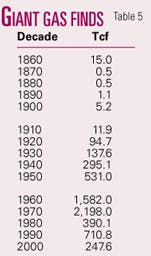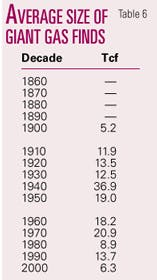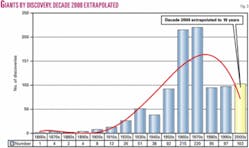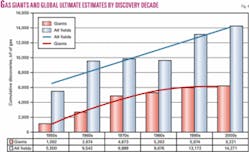This is the second part of a two-part article that lists world giant oil and gas discoveries by decade and analyses related trends.
Table 1 summarizes the decade-by-decade changes in oil and gas giant field discoveries. A familiar pattern can be seen of major increases that occurred in the 1960s and 1970s, followed by a dropoff in the last 2.6 decades (decade 2000 consists of a partial record from year 2000 through year 2006).
Another trend shown in Tables 1 and 2 is that since the 1990s, giant field gas discoveries have surpassed giant field oil discoveries.
The basic picture combines the oil and gas giants and superimposes a second-order trend line (Fig. 2). The total number of 938 giant fields includes 555 oil fields and 383 gas fields.
In Fig. 2, we predict the number of giant discoveries in decade 2000 based upon the record through year 2006. Since Jan. 1, 2000, 72 giant fields have been discovered. This averages to 10.28 discoveries/year; therefore the extrapolation to the end of decade 2000 is 103 discoveries. If this prediction holds up, the current decade will surpass the 100 discovery number for the first time since decade 1970.
Giant oil fields
We next divide the study into oil on the one hand and gas on the other.
First, with regard to oil, Table 3 shows ultimate reserves in billions of barrels. Decade 1960 is the peak.
The five largest oil fields discovered in decade 1960 (in billions of barrels of estimated ultimate recovery) were Zakum, Abu Dhabi (17.2); Shaybah, Saudi Arabia (15.7); Prudhoe Bay (Prudhoe Bay and 10 other oil pools), US, (15.3); Marun, Iran, (12.6); and Zuluf, Saudi Arabia (12.2).
Table 4 represents average giant oil field size. Decade 1940 leads the list with an average giant oil field size of 4.67 billion bbl. Ghawar, Saudi Arabia, is the greatest contributor to the decade 1940 average, with 66.1 billion bbl ultimate; thus providing 47% of the average. As noted by the Centre for Global Energy Studies,5 the trend for more recent giant discoveries seems to be one of decreasing size.
Giant gas fields
The rest of the historical analysis concerns the giant gas fields.
Table 5 shows ultimate reserves in trillions of cubic feet. Decade 1970 is the peak with 2,198 tcf.
The five largest gas deposits discovered in decade 1970 (in trillion cubic feet EUR) were North field, Qatar (900); Astrakhan, Russia (89.6), Northwest Dome, Qatar (80), Bovanenko, Russia (76.4); and Kyrtaiol’skoye, Russia (55).
Table 6 represents average gas associated with giant fields. Decade 1940 leads the list with an average gas deposit size of 36.9 tcf. Ghawar, Saudi Arabia, is the greatest contributor to the decade 1940 gas average with 186 tcf, thus providing 63% of the average.
Expected recoveries
We next turn our attention to estimating the percentage of ultimate recoverable oil and gas that can be accounted for by giant fields. We do this by:
- Establishing a current estimate of ultimate recoverable for oil and gas. In order to obtain this estimate, we use Salvador’s6 Tables 8 and 13 prediction compilations of industry, government, and academia experts. Averaging the most recent (2006) data from these tables, we arrive at a value of 2,918 billion bbl of oil (decade 2000 column, Fig. 3); and 14,271 tcf of gas (decade 2000 column, Fig. 4).
- Determining the total ultimate recoverable for giant fields, both oil and gas. These values are derived from Horn,4 modified to take into account decade 2000 discoveries. These numbers are of 1,210 billion bbl of oil (decade 2000s column, Fig. 3) and 6,176 tcf of gas (decade 2000s column, Fig. 4).
null
The resultant data and prediction of giant field contributions are summarized in Table 7. The contribution percentages are low when compared to the industry’s conventional wisdom estimates of about 50%, but they may reflect the new paradigm of greater contribution of smaller fields to the world’s hydrocarbon inventory.
null
Main points
- Giant field discoveries peaked in decades 1960 and 1970.
- Since decade 1990, giant field gas discoveries have surpassed giant field oil discoveries.
- The total number of giant fields is 938; the current decade will surpass the 100 discovery number for the first time since decade 1970.
- Decade 1960 was the peak for adding ultimate giant oil field reserves; 1970 was the peak decade for adding ultimate giant gas field reserves.
- Decade 1940 was the peak year with regard to average oil and gas giant field additions, due primarily to the discovery of Ghawar field.
- Giant oil fields will contribute 41% to the projected ultimate world oil inventory of 2,918 billion bbl.
- Giant gas fields will contribute 44% to the projected ultimate world oil inventory of 14,271 tcf.
References
- Rigzone, 2005 (http://www.rigzone.com/data/projects/project_detail.asp?project_id=87).
- AGIP, 2006 (http://www.agipkco.com/en/what_we_doing/kashagan_en.htm)
- Walker, T.R., and Kantsler, A.J., “Deepwater and Frontier Exploration in Australia-A Historical Perspective and a View to the Future,” IPA-AAPG Deepwater and Frontier Symposium, 2004, pp. 471-480.
- Horn, M.K., “Giant fields 1868-2003,” Data on CD-Rom, in Halbouty, M., ed., “Giant oil and gas fields of the decade 1990-1999,” AAPG Memoir 78, 2003, 340 pp., modified November 2006 to reflect giant oil discoveries 2000-06.
- “World giant oil discoveries seem not to be at an end,” OGJ, Nov. 6, 2006, p. 33.
- Salvador, Amos, “Energy: A historical perspective and 21st century forecast,” AAPG Studies in Geology No. 54, 2005, pp. 33-121.
The author
Myron (Mike) Horn ([email protected]) has been an independent consultant the past 20 years in Tulsa, where he has specialized in giant field, burial history, source to reservoir, heavy oil, and natural fracture information systems. Before that, he was exploration and production research director for Cities Service Oil Co. for 15 years. A past elected editor of the AAPG Bulletin, he has a BS from the University of Colorado, an MS from the University of Houston, and a PhD from Rice University, all in geology.
